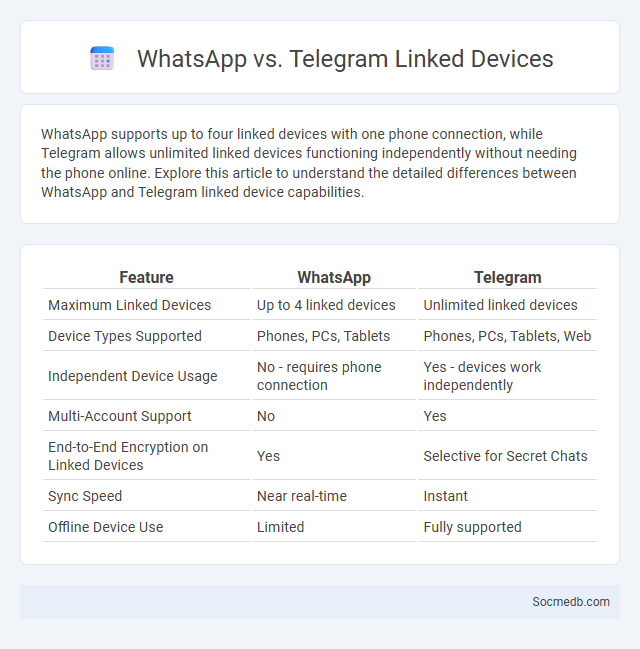
Photo illustration: WhatsApp vs Telegram Linked Devices
WhatsApp supports up to four linked devices with one phone connection, while Telegram allows unlimited linked devices functioning independently without needing the phone online. Explore this article to understand the detailed differences between WhatsApp and Telegram linked device capabilities.
Table of Comparison
| Feature | Telegram | |
|---|---|---|
| Maximum Linked Devices | Up to 4 linked devices | Unlimited linked devices |
| Device Types Supported | Phones, PCs, Tablets | Phones, PCs, Tablets, Web |
| Independent Device Usage | No - requires phone connection | Yes - devices work independently |
| Multi-Account Support | No | Yes |
| End-to-End Encryption on Linked Devices | Yes | Selective for Secret Chats |
| Sync Speed | Near real-time | Instant |
| Offline Device Use | Limited | Fully supported |
Overview: WhatsApp vs Telegram Linked Devices
WhatsApp supports linking up to four devices simultaneously with one phone, allowing seamless access without the phone being constantly online. Telegram offers a more flexible approach by enabling unlimited linked devices, including tablets and computers, with independent cloud-based messaging synchronization. This difference highlights Telegram's advantage in device versatility and accessibility compared to WhatsApp's more restrictive multi-device management.
Key Features of Linked Devices on WhatsApp
Linked Devices on WhatsApp enable users to access their accounts simultaneously across multiple devices without needing the primary smartphone to stay online. This feature supports up to four linked devices and one phone, allowing seamless messaging with end-to-end encryption maintained for all sessions. Users can manage linked devices via the app's settings to enhance security, including the ability to log out from individual devices remotely.
Key Features of Linked Devices on Telegram
Linked Devices on Telegram enable seamless access to your account across multiple devices without compromising security, utilizing end-to-end encryption and secure cloud synchronization. Users can view active sessions, manage connected devices, and remotely log out to maintain control over account activity. This feature enhances convenience and protection by ensuring continuous connectivity while safeguarding personal data on desktop, mobile, and web platforms.
Device Support and Compatibility Comparison
Social media platforms offer broad device support, including smartphones, tablets, desktops, and smart TVs, ensuring seamless user experience across iOS, Android, Windows, and macOS operating systems. Compatibility extends to various web browsers like Chrome, Safari, Firefox, and Edge, enabling efficient access and functionality for features such as live streaming, messaging, and multimedia sharing. Advanced technologies like responsive design and Progressive Web Apps (PWAs) enhance performance and accessibility on diverse devices, driving higher engagement rates and user retention.
Security and Privacy in Linked Devices
Managing security and privacy on linked devices is crucial to protect your personal information and prevent unauthorized access to your social media accounts. Ensure that multi-factor authentication is enabled across all devices, and regularly review connected devices in your account settings to identify and remove any unfamiliar or unused ones. Using encrypted connections and strong, unique passwords for each device adds an extra layer of protection for your digital identity.
Multi-Device Sync: Performance and Limitations
Multi-device sync in social media platforms enhances user experience by enabling seamless access to content across smartphones, tablets, and desktops, ensuring real-time updates and consistent notifications. However, performance limitations include latency issues, data synchronization conflicts, and increased battery consumption, particularly on devices with weaker hardware or slower network connections. Optimizing backend infrastructure and employing adaptive syncing algorithms can mitigate these challenges, improving reliability and user satisfaction.
Account Management Across Linked Devices
Managing your social media account across linked devices ensures consistent access and enhanced security. Synchronize settings, notifications, and privacy controls on smartphones, tablets, and desktops to maintain seamless user experience. Use two-factor authentication and device management features to protect your account from unauthorized access.
Notifications and Message Delivery Differences
Social media platforms differentiate through notifications and message delivery systems to enhance user engagement and real-time interaction. Platforms like Facebook use push notifications for likes and comments, while Twitter emphasizes instant alerts for mentions and retweets, affecting user response times. Messaging apps integrated within social networks, such as Instagram Direct and WhatsApp, prioritize encryption and message status indicators, influencing communication privacy and reliability.
User Experience and Setup Process
Optimizing social media platforms for seamless user experience enhances engagement by simplifying navigation and content discovery. Your setup process should be intuitive, guiding you through account creation, profile customization, and privacy settings with minimal steps. Streamlined onboarding reduces friction, encouraging active participation and long-term platform loyalty.
Which Platform Handles Linked Devices Better?
Facebook excels in handling linked devices through its comprehensive account management and security features, allowing seamless synchronization across smartphones, tablets, and desktops. Instagram, owned by Facebook, also provides smooth device linking but lacks Facebook's extensive privacy controls and multi-device monitoring tools. When managing your linked devices, Facebook offers more robust options for controlling access and ensuring your account's security across various platforms.
 socmedb.com
socmedb.com